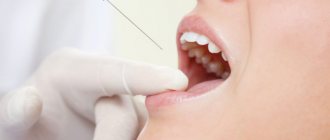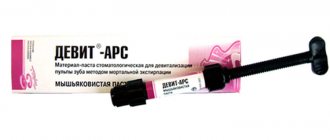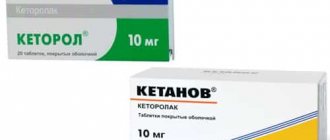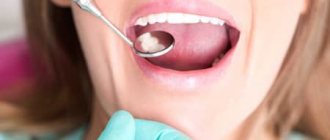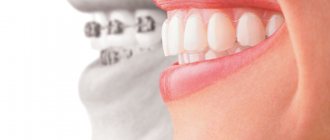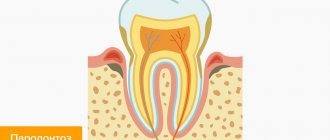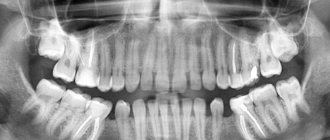Features of the use of anti-inflammatory drugs for joints
Prolonged pain creates a stressful situation for a woman.
When pain occurs, the body produces stress hormones. But since a pregnant mother and her child are practically a single organism, stress is inevitably transferred to the child. Stress hormones have a stimulating effect on muscles, including (and especially) the muscles of the uterus. As a result, a pregnant woman with chronic pain may experience miscarriage or premature birth.
This is one side of the coin. On the other hand, it is unacceptable to relieve pain simply by taking painkillers and not consulting a doctor.
Pain is the body's signal that something is wrong. This signal must be perceived in time by a person in order to find the true cause of this symptom. By directly influencing the cause, we can count on relief from pain and recovery.
Moreover, taking painkillers can mask and blur the clinical picture of many diseases, for example, acute appendicitis. As a result, time may be lost during which the woman could have received help and prevented the disease from progressing.
In other words, you need to be smart about taking any medications. That is, there is no need to self-medicate, and you can take painkillers without a doctor’s recommendation only when it is not possible to see a doctor here and now. For example, if you wait a long time for an ambulance on a weekend or holiday. Or if there is no way to contact for acute pain when your teeth hurt.
Medicines that suppress pain in pregnant women are available in 5 main forms. Each form differs in its purpose, so only the attending physician can choose the most optimal option. Painkillers for pregnant women have the following release forms:
- Tablets and capsules. During pregnancy, their advantage is the speed of action and high efficiency. Most tablets dissolve only when they enter the intestines, so they do not irritate the stomach. Drugs that dissolve in the stomach can cause toxicosis and vomiting.
- Candles. They differ in the duration of action, but in terms of the speed of onset of the effect they are significantly inferior to drugs in capsule form. As a rule, they are placed at night in order to wake up in the morning without pain.
- Injections. Painkillers in the form of injections act most quickly, since the medicine enters the bloodstream immediately after injection. They are prescribed only in the most extreme cases, when pain relief with other drugs does not bring the desired effect.
- Ointments. Ointments and gels are mistakenly considered the safest for pregnant women. In fact, their active substance, like the active component of tablets or capsules, penetrates into the blood and can adversely affect the health of the fetus (if the drug is abused or self-medicated).
During pregnancy, you may experience frequent headaches. It may be a sign of high blood pressure. Hypertension during pregnancy appears quite often. But this does not mean that this pain must be endured. Pay attention to how often you experience headaches. Be sure to monitor your blood pressure.
It is advisable to measure your blood pressure daily, so you will be aware of the changes that occur in the body. If you notice any changes, you will be able to quickly respond, preventing possible consequences. You can leave a note in the medicine cabinet with an exact list of medications that can be taken for high blood pressure, low blood pressure, and pain of various origins.
Your doctor should help you create this list. During pregnancy, the body may react to changes in temperature, atmospheric pressure, stress or fatigue. You must be prepared for any of his reactions. Also remember that it is better not to wait for pain to appear, but to try to prevent it. If you haven't visited the dentist in a while, do so. After all, acute toothache can bring a lot of discomfort.
Women during pregnancy sometimes cannot do without the use of analgesics, for example, with sharp pain in the lower abdomen. Before starting to take any medication, the expectant mother should consult with her doctor.
The drugs must be prescribed by a qualified specialist who will decide on the need to prescribe the medication and determine the dose, while he must monitor the well-being of the expectant mother and child. Some analgesics can only be used in the 2nd or 3rd trimester, while others are allowed at any time.
Severe or chronic pain, if not treated at all or treated with inadequate methods, can have adverse effects on the body of the woman and the fetus. Even if we forget about the emotional connection and the fact that the child feels the mother’s mood, in any case, the fetus is completely dependent on the female body, receiving oxygen and nutrients for growth and development.
If possible, non-pharmacological measures should be used, but if they do not work, the most effective painkillers for the pregnant woman are selected according to the severity of the condition, taking into account known or suspected risks to the fetus.
We briefly told you what painkillers you can take during pregnancy, but we forgot about a very important factor, namely: in what trimester such trouble happened that you needed the help of a dentist. It is especially difficult to choose medications for women in the first trimester, when the placenta has not yet started working, and the child is completely unprotected from external influences.
The pharmacological effect of NSAIDs is expressed by blocking the enzyme cyclooxygenase (COX), which is responsible for the formation of substances (mediators) in the body that support inflammation. Thanks to the inhibition of mediators, the inflammatory process is relieved, swelling and pain in the joints are reduced.
NSAIDs are produced in the form of selective and non-selective inhibitors of cyclooxygenase, which, in turn, comes in two types: COX-1 and COX-2. Medicines of both series have anti-inflammatory and analgesic effects.
Distinctive features of this group of drugs are:
- rapid onset of therapeutic effect;
- high degree of damage to the mucous membrane of the gastrointestinal tract;
- inhibitory effect on the synthesis of cartilage tissue;
- short duration of action;
- the permissibility of therapy in any combination, due to the variety of pharmaceutical forms of release;
- the ability to achieve both isolated (local) and systemic effects.
This group is distinguished by the following features:
- minimal negative effect on the digestive tract;
- beneficial effect on the synthesis of cartilage tissue;
- suitable for long-term use;
- toxic effect on the liver.
Non-steroidal anti-inflammatory drugs for the treatment of joints, tablets and any other forms have precautions for their use:
- Instructions for use must be followed.
- Most NSAIDs have a large list of side effects and contraindications. These medications can be taken with caution for diseases of the stomach, liver, intestines, kidneys, heart, as well as during pregnancy.
- Alcohol and NSAIDs are incompatible.
- You can limit the negative effects on the mucous surface of the gastrointestinal canal by drinking plenty of water with anti-inflammatory tablets.
The most convenient dosage forms of anti-inflammatory drugs are tablets or capsules. This is a form of painless, but no less effective influence on the source of inflammation. Tablets that relieve joint inflammation exist in the pharmacological groups of NSAIDs and glucorticoids.
List of effective non-steroidal tablets for joint inflammation:
- Indomethacin;
- Piroxicam;
- Diclofenac;
- Voltaren;
- Methindol;
- Ibuprom;
- Ibuprofen;
- Nurofen;
- Ketanov;
- Ketonal;
- Nimesulide;
- Nise;
- Meloxicam;
- Movalis;
- Revmoxicam;
- Melbek;
- Celebrex et al.
We suggest you read: How to treat salt deposits in joints at home
Despite the availability and variety of medical products, which pills to choose for joint inflammation should only be decided by a doctor.
Anti-inflammatory therapy for joints is carefully selected by a rheumatologist and has a number of features:
- The selection of analgesics is carried out from weak to strong, with the exception of severe pain.
- Severe pain in the joints can be relieved with injections; taking pills in this case is less advisable.
- Acute sudden inflammation of the joints is best treated with NSAIDs.
- Chronic inflammatory processes require long-term therapy using hormonal and other auxiliary agents.
Tablets for hemorrhoids and fissures
Painful sensations often appear after defecation, when the stool touches the inflamed enlarged hemorrhoids. The pain can be so severe that a person cannot bear it. Actually, the choice of a suitable painkiller depends on the strength of the pain.
Since the tablets are quickly absorbed by the tissues of the esophagus and enter the intestines, the effect occurs much faster than with suppositories. Also, the advantage on the side of this form of the drug is that it is not entirely pleasant to place suppositories in the anus, which hurts so much.
Painkillers for hemorrhoids are taken from the group of analgesics, antispasmodics, and nonsteroidal drugs.
- Analgesics act faster than others. The therapeutic effect occurs within 10 minutes and lasts about 6 hours. It is recommended to take it twice a day, but if the pain is severe, increase the dosage or frequency of administration up to 4 times.
- Antispasmodics act more slowly. The pain goes away gradually. The tablets affect the cause of discomfort - spasm. In the later stages of hemorrhoids, pain occurs due to pinching of the hemorrhoidal node and compression of the nerve endings. Antispasmodics relax muscles, thereby eliminating pain. The therapeutic effect lasts longer than in the first case.
- Non-steroidal drugs have several properties at once - they relieve pain, relieve inflammation, and swelling. The pain disappears 20 minutes after taking the tablet. Can be taken three times a day. Exceeding the dose of non-steroidal tablets negatively affects the functioning of the digestive organs.
You should not take any painkillers for a long time. It is necessary to undergo a full course of treatment for hemorrhoids, and painkillers should be used in extreme cases.
Difficult decision
If arthrosis is detected before conception, then you need to try to cure it because during pregnancy, untreated gonarthrosis or coxarthrosis will place a heavy burden on the knee or hip joints, which will already experience additional stress when bearing a child. In some cases, arthrosis worsens due to pregnancy, but most often, after three months of pregnancy, the symptoms of joint disease subside and flare up after childbirth.
After the successful birth of a child, you need to clearly understand that physical activity will increase many times over, so the woman must be prepared for the fact that she will have to be on her feet a lot, rocking the baby in her arms, and with sore legs and arms this becomes very problematic. Therefore, it is strongly recommended to weigh all the nuances that deforming arthrosis imposes on the female body:
- Determine the severity of osteoarthritis;
- Identify functional disorders in the body;
- Have a complete picture of laboratory and clinical tests;
- The desire and ability of family and friends to help during pregnancy and after it.
The most important thing, of course, will be the desire of the woman herself to become a mother.
General recommendations during pregnancy for patients with arthrosis
The most common joint diseases are:
- arthritis and its types (synovitis, spondyloarthritis, etc.);
- bursitis;
- arthrosis;
- gout;
- Bekhterov's disease;
- arthropathy, etc.
Elimination of inflammation is carried out using pharmacological agents in combination with supportive therapy (physiotherapy, moderation of physical activity, physical therapy, etc.). In extreme cases, surgery is used.
The scheme for relieving inflammation with drugs for these diseases involves a complex of means and is as follows:
- The use of non-steroidal anti-inflammatory drugs to relieve the inflammatory process.
- Medicinal injections of hormonal drugs to relieve inflammation in particularly severe cases.
- Antibacterial therapy with antibiotics when a viral, bacterial or fungal infection is detected.
- The use of chondroprotectors and muscle relaxants to restore the integrity of cartilage tissue and eliminate muscle spasms.
- The use of vitamin-mineral complexes and immunomodulators for general stimulation of the immune system.
The use of several groups of medications will help solve the problem of joint inflammation in a shorter time.
The main difference from conventional rehabilitation therapy will be a reduction in doses of medications or even exclusion of them from the course of treatment. Almost all non-steroidal anti-inflammatory drugs are contraindicated during pregnancy. Some exceptions are intra-articular injections of corticosteroids, which will not have a detrimental effect on the fetus.
Treatment of arthrosis during pregnancy should be accompanied by close cooperation of a rheumatologist, orthopedist, therapist and obstetrician-gynecologist. Competent therapy will prevent osteoarthritis from worsening; an individual plan for taking medications will be selected and a special orthopedic regimen will be prescribed. You should not refuse the advice of an orthopedist on wearing corsets, knee pads, elbow pads, Shants collars and other orthopedic devices that ease the course of the disease and do not complicate the period of bearing a child.
With the slightest suspicion of exacerbation of arthrosis, you should urgently seek help from a doctor, since the inflammatory processes that accompany joint disease, along with severe pain, can greatly complicate pregnancy.
Physiotherapy
Another excellent opportunity to treat arthrosis is clay and mud therapy, visiting sanatoriums where you can take mud baths, which have the best effect on joint health, muscle tone, and cartilage tissue.
Herbal medicine and traditional medicine can make a positive contribution. Compresses, tinctures, rubs, lotions, baths made with medicinal plants and natural ingredients will be safe for the health of the expectant mother and her pregnant child. The effect, of course, is not as fast as we would like, but there are no dangers that can arise when treated with medications when miscarriages or premature births occur.
Compresses made from cinquefoil, as well as gels from this miracle plant, which are sold in pharmacies, will greatly help your joints. You can use burdock instead of cinquefoil, which is also not difficult to find, but its benefits are significant.
The use of natural honey will be mandatory, against which even conservative doctors will not say anything. Apitherapy (honey compresses, consumption of honey, pollen, wax applications, use of propolis) during pregnancy gives excellent results! The only contraindications are apitoxin therapy. Bee products will increase the immunity of a pregnant woman, remove toxins, normalize weight, and saturate the body with vitamins and microelements.
Chondroprotectors
Treatment is prescribed individually. Aimed at eliminating the causes of development. Approved anti-inflammatory drugs are administered. In case of acute symptoms, antibiotics are prescribed. Physiotherapeutic procedures are prescribed.
Acetylsalicylic acid is contraindicated before pregnancy at 10 weeks and before childbirth - it will disrupt the correct development of the fetus and lead to bleeding. You should not take cytostatic drugs that reduce immunity, or non-steroidal anti-inflammatory drugs. Pyrazolone drugs are not recommended.
We invite you to read: What is arthrosis of the facet joints and why the disease is dangerous
Pregnant women should reduce the load on the digestive organs, liver and kidneys - exclude spicy and fatty foods, canned foods, chocolate, coffee and alcoholic drinks. It is worth introducing steamed or oven-cooked food, more fruits and vegetables into your diet. Do not overuse citrus fruits, which affect the occurrence of arthritis.
Recommendations to alleviate the disease: proper nutrition, swimming and race walking.
Traditional recipes to help relieve pain:
- Eucalyptus oil-based compresses will relieve pain and reduce inflammation. This is also facilitated by ointment made from hop cones or St. John's wort inflorescences: 2 tbsp. Grind tablespoons of dried herbs to a powdery form and mix with 50 grams of Vaseline, grind the mass until smooth. Apply the ointment to the sore spot.
- For prevention, a decoction of potato peelings can be used to warm your hands or feet, which hurts. The procedure lasts half an hour; after the limb, rinse with water at a comfortable temperature and lubricate with almond, castor or apricot oil. The baths have accompanying positive effects: the skin on the hands will become smooth and pleasant to the touch, the nails will be stronger, cracks, corns, and gouty nodes will disappear on the heels of the feet.
- To reduce pain, wrap the affected area with leaves of coltsfoot (spring), burdock (summer, autumn), cabbage (winter). With long-term use, you can forget about pain for a long time.
Traditional medicine offers many recipes to treat illness or reduce pain. When deciding to use them, it is important to enlist the support and permission of a doctor in order to avoid negative effects on the health of mother and child.
Arthritis during pregnancy is less active or does not manifest itself, so we should hope that the wonderful period of waiting for the baby will not be overshadowed by anything!
We invite you to read: Torn internal meniscus of the knee joint consequences
Treatment of arthrosis during pregnancy should be accompanied by close cooperation of a rheumatologist, orthopedist, therapist and obstetrician-gynecologist. Competent therapy will prevent osteoarthritis from worsening; an individual plan for taking medications will be selected and a special orthopedic regimen will be prescribed. You should not refuse the advice of an orthopedist on wearing corsets, knee pads, elbow pads, Shants collars and other orthopedic devices that ease the course of the disease and do not complicate the period of bearing a child.
Physiotherapy
Physiotherapy is recognized as one of the safe methods for treating a pregnant woman for arthrosis of the knee, cervical, shoulder, and hip joints. Modern devices make it possible to remarkably suppress the signs of the disease - pain, inflammation, without harming the surrounding tissues and, especially, the fetus. It is advisable to purchase a physiotherapy device so that you can be treated at home.
Chondroprotectors
Preparations containing glucosamine and chondroitin are useful for restoring damaged cartilage tissue, but pregnant women are not recommended to take them orally in tablets. However, intra-articular injections of chondrotherapy are allowed; such injections will not harm the fetus. It is advisable to saturate the body with them before conception.
If you have firmly decided to have a child, but know about your diagnosis of arthrosis of the joints, then you need to make sure that you are not overweight. Excess body weight is a scourge for the joints of the limbs and spine with osteoarthritis. The load on them increases sevenfold, plus the natural weight gain of the expectant mother will aggravate the situation of sore knee joints, feet, and hip bones.
Any doctor or nutritionist will tell you how important it is to establish a healthy diet; it makes no sense to repeat it again, but for some reason young mothers lose sight of this simple truth. Saturate your body with everything healthy, avoid chemical preservatives, flavor enhancers, flavorings that will have a bad effect on the condition of joints, cartilage, ligaments and joint fluid in arthrosis.
Swimming while pregnant is beneficial. It will strengthen the muscles and give strength to the ligamentous apparatus. Swimming in a pool or pond alone will not cure deforming osteoarthritis, but it will keep your joints healthy longer, and after childbirth you will have the opportunity to treat more aggressively. Walking for up to an hour in the fresh air is useful; if you feel tired, be sure to take a break, sit down, and rest.
Gymnastics for pregnant women with arthrosis is permissible in early pregnancy, and the exercises should be discussed with a gynecologist. This should be gentle physical therapy to increase the range of motion of joints, increase flexibility and strength of muscles, and prevent their atrophy. A set of exercises is selected based on the type of arthrosis and the duration of pregnancy.
Situations in which painkillers may be needed
Toothache, earache, headache, nagging pain in the abdomen, pain in the lower back and joints, pain during sprains, bruises and fractures, burns, as well as acute appendicitis, renal colic - this is an incomplete list of possible causes of pain in pregnant women.
Useful: Homocysteine during pregnancy
Toothache is a topic that is especially relevant for expectant mothers, since during pregnancy the female body experiences a lack of calcium and phosphorus.
Nature arranges everything in such a way that the child can be guaranteed to receive all the microelements and vitamins he needs. The baby will still take everything he is entitled to, even at the expense of the mother’s body reserves. Therefore, the destruction of dental tissue and the addition of caries during pregnancy are not uncommon for women.
Ideally, of course, you need to sanitize your oral cavity before planning a pregnancy. But even this step, unfortunately, does not provide one hundred percent protection against painful dental problems for the expectant mother.
Inflammation in the joints is often accompanied by a weakened immune system. Strengthening the immune and skeletal system with vitamins and minerals, especially calcium-containing preparations, is a necessary measure for joint diseases. As a result of the use of these medications, there will be an absence of vitamin deficiency and osteoporosis, as well as an increase in the body’s resistance to attack by pathogenic microorganisms.
List of recommended vitamin-mineral complexes and calcium-containing preparations:
- Alpha D3-Teva;
- Vitrum;
- MultiTabs;
- Centrum;
- Immuno;
- Osteogenon;
- Alphabet;
- Osteocea;
- Calcemin Advance;
- Calcium-D3 Nycomed et al.
Cold medicines for pregnant women
What cold medicines can expectant mothers use? The answer to this question is clear - all medications that are suitable for treating children under 3 years of age are not prohibited for pregnant women. All anti-cold medications can be divided into several groups:
- Anti-fever remedies. You can bring down a high temperature with Paracetamol tablets and its analogues (Efferalgan, Panadol). If the fever does not subside, you should seek medical help.
- Cough medicines. Mucaltin, Bromhexine, Doctor Mom syrup, ACC will help cure a cough in an expectant mother.
- Remedies for sore throat. The safest remedy for treating pharyngitis, sore throat and tonsillitis in pregnant women is rinsing with a water-salt solution. Also, expectant mothers are allowed to treat a sore throat with Chlorhexidine solution. You can use Iodinol and Lugol, but only for a short time and after consulting a doctor.
- Cold medicine. Naphthyzin drops for children are mainly used. However, their use must be coordinated with your doctor. During pregnancy, you can treat a runny nose with drugs based on natural oils, saline solutions or purified sea water (Pinosol, Salin, Aqua Maris, Aqualor, etc.).
- Antiviral agents. To treat a viral infection, it is best to use Immunal drops, Interferon tablets or Grippferon suppositories.
- Antibiotics. They are not prescribed for colds, but any viral disease can be complicated by a bacterial infection. What antibiotics are allowed for pregnant women? It is difficult to identify a particularly safe group. Most drugs do not have pregnancy on the list of contraindications, but self-medication is strictly prohibited; you must first consult with your physician and gynecologist.
Due to reduced immunity, colds during pregnancy are the most common companion of women. Fever, runny nose and headache, herpes on the lips, body aches and weakness, cough and sore throat are all signs of illness that require immediate treatment. Let's look at what medications pregnant women can take for a cold.
The cause of colds in the vast majority of cases is influenza or ARVI viruses. The use of antiviral drugs is indicated only in case of urgent need, with special caution in the 1st trimester. Pregnant women can use the following medications for ARVI and influenza for pregnant women.
- Tamiflu, Relenza, Nomides, Influcein, Acyclovir - directly destroy the virus.
- Viferon (from 14 weeks), Grippferon, Giaferon (with caution), Oscilococcinum - have an immunostimulating and antiviral effect.
Pregnant and breastfeeding women can use Nazaval Plus spray as a prophylactic against ARVI.
Seeing a doctor is the key to your baby’s health
During pregnancy, the expectant mother always wants to feel protected and not worry about anything. But what if there is pain, the causes of which you don’t understand? In this case, it is better to immediately consult a doctor who will determine the source of the pain. You will most likely be asked questions about the duration of the pain attack and its strength, and depending on this, the doctor will try to determine the main etiology (i.e., cause) of the pain and offer several options for relieving this problem. Pain should not be a companion to a pregnant woman
Pain-relieving injections during menstruation
The advantage of using analgesics in the form of injections is the rapid impact of the active components on pain and the absence of a negative effect on internal organs. As practice shows, this “ambulance” requires outside help, which means it cannot be used at any time and in any place.
In most cases, an injection is given as a last resort if the pain cannot be relieved either with tablets, suppositories, or decoctions or patches. Experts say that in case of strong, repeated cramps during menstruation, it is necessary to administer injections:
- Analgina;
- Baralgina;
- Lidocaine;
- Novocaine;
- Diclofenac;
- Mydocalma;
- Ketonala;
- Ibuprofen.
Self-prescription of this dosage form or arbitrary dose adjustment is not allowed! Painkilling injections, regardless of the “power” of the active ingredients, must be given under the strict supervision of the attending physician!
The first trimester is a dangerous period
In the first trimester, you always need to think again about whether it is worth taking any medications, especially painkillers. It is during this period that the risk of negative effects of drugs on the fetus is especially high, since in the first months of pregnancy the child develops rapidly, most of the vital systems and organs of the baby are formed, the development and formation of which can be negatively affected by any external factor.
Also, in the first months of pregnancy, metabolic processes occur intensively in the bodies of both the mother and the child, and the not yet fully formed placenta cannot adequately perform its barrier function. This is why most medications, including painkillers, are contraindicated in the first three months of pregnancy.
Of the painkillers, Paracetamol is considered the safest. Its safety for pregnant women and children is confirmed by the World Health Organization. It is contraindicated for women with kidney disease, liver disease and erosive diseases of the gastrointestinal tract. Paracetamol, in addition to its analgesic effect, also has an antipyretic effect. All over the world, Paracetamol is recognized as the drug of choice for fever in young children. This also indicates high confidence in the drug.
Drug categories
In obstetric practice, there is a classification of five groups of drugs, reflecting the expected harm of the drug to the fetus:
- A - there is no risk to the fetus during human studies.
- B - there is no risk to the fetus during animal studies.
- C - use is possible only under strict indications; animal studies have revealed a risk to the fetus.
- D - a risk to the fetus was identified in human studies. Admission is possible if there are vital indications.
- X - high risk to the fetus during human studies.
We suggest you read: Causes and treatment of shoulder pain when moving the arm back
When prescribing drugs, you should choose drugs from the first two groups. Before using any medications, the expectant mother is advised to consult a doctor.
Alternative Methods for Pain Control
If pain occurs, this condition can be alleviated with a light and relaxing massage. Aromatherapy also helps quite well in this situation, for example, you can take a warm bath and add a few drops of frankincense essential oil to it. This procedure will normalize the nervous system, help relax the muscles of the body and help cope with pain.
There are also various physical exercises that can help relieve pain in various areas of the body. In addition, such exercises will help keep your muscles toned, which is of no small importance.
Constipation remedies
Problems with stool during pregnancy are recommended to be solved with the help of optimal physical activity, proper drinking regimen and a balanced diet. If a pregnant woman experiences constipation, it is necessary to enrich the diet with foods with fiber (white cabbage, beets, buckwheat porridge, prunes, bran bread, etc.).
If it is impossible to cope with the problem without medication, the safest and most effective drugs should be used. Approved medications for constipation when carrying a baby at any time include Duphalac syrup, Senadexin tablets, and glycerin suppositories. Regulax is widely used in the 2nd and 3rd trimesters.
Paracetamol
A single dose of Paracetamol should not exceed 500 mg. The doctor monitoring your pregnancy will tell you the daily dose.
It is important to understand that even such cold powders as Theraflu, Coldrex, Fervex contain Paracetamol. And if they were recommended to you to relieve the symptoms of a cold, then you no longer need the additional use of Paracetamol and other analgesics. Otherwise, additional intake of painkillers may lead to an overdose.
What tablets can be given to children for stomach pain?
The list of drugs that are approved for children is small. Some have an older age prescribed in the official instructions, but doctors use them in pediatric practice from 3 years of age or even earlier, if required.
- No-shpa;
- Trimedat;
- Mezim;
- Motilium.
No-shpa is considered the safest remedy for children. It is prescribed as a quarter or half of a tablet; to make it easier to swallow, it is crushed into powder. It should be borne in mind that it has a very bitter taste, so you need to be careful that the child does not spit it out.
How does a painkiller pill work?
When inflammation develops in the infected pulp or periodontal tissues, they produce enzymes that signal problems - prostaglandins. Prostaglandins go to pain receptors - nerve endings, and “turn on” pain.
Analgesics block the release of signaling enzymes, so pain disappears some time after taking them. The cause of toothache is an infection or inflammatory process that is not eliminated, and unpleasant symptoms reappear after a while.
Ibuprofen
If it is impossible to take Paracetamol, the doctor may prescribe Ibuprofen to the pregnant woman. This drug can be produced under different trade names, such as Nurofen, Ibufen.
Ibuprofen is approved for use in pregnant women in the first and second trimesters of pregnancy. It is prohibited to take it in the third trimester of pregnancy, as it significantly affects the amount of amniotic fluid and reduces it.
Useful: Why does the stomach itch in pregnant women?
Pain relief in a dental clinic
What will help you get rid of toothache 100%? Visit to the dentist.
Modern clinics are equipped with everything necessary for the safe diagnosis and treatment of pregnant women - radiovisiographs, intraoral cameras and systems for painless administration of anesthesia. Therefore, there is no need to be afraid that the procedures will harm you, your baby or cause even more pain.
The dentist will determine the cause of the problem and do:
- treatment of caries or its complications – pulpitis and periodontitis;
- extirpation (removal) of the neurovascular bundle, pulp;
- removal of a diseased tooth.
For acute pain, procedures are performed under local anesthesia, so you will feel relief immediately after the administration of the anesthetic.
Pulp extirpation
For pain relief during pregnancy, anesthetics with rapid action and minimal harm are used:
- articaine: ultracaine, alfacaine;
- mepivacaine: scandonest, isocaine.
Both drugs do not cause allergic reactions, begin to act 1-4 minutes after administration and are not toxic to the baby in the womb - if necessary, they are administered even to newborn children (mepivacaine).
An injection of an anesthetic and removal of infected tooth tissue is much safer for the expectant mother and fetus, compared to taking a single dose of analgesic medication. But most importantly, they allow you to get rid of pain and further spread of infection.
So don’t waste your time and health on debilitating toothache - use the MyDentist search engine to make an appointment at the nearest 24-hour dentist!
Read more about caries during pregnancy in our article.
Experts are inclined to believe that the use of local medicines does not have a significant effect on the entire body. Therefore, the use of dental gels is preferable to tablets during pregnancy.
Holisal
Cholisal is an antimicrobial, analgesic agent for topical use. The active ingredient is choline salicylate, cetalkonium chloride.
The gel is well absorbed when applied to mucous membranes and inhibits the activity of bacteria, fungi and viruses. The effect develops quickly, within 2 - 3 minutes, and lasts for 2 - 8 hours.
Kalgel
Kalgel is a local anesthetic and antiseptic. The active ingredients are lidocaine hydrochloride and cetylpyridinium chloride. The product blocks pain and inhibits the growth of bacteria and fungi.
It is noteworthy that this drug is prescribed to relieve pain and reduce irritability of the gums during teething in children aged 3 months and older. If necessary, it is permissible to reapply the gel to damaged tissues, but no more than 6 times a day.
Kamistad is a local anesthetic and antiseptic. The active ingredients are lidocaine hydrochloride monohydrate and chamomile extract.
It is recommended to apply the gel to the affected areas 2-3 times a day, spreading it over the surface of the gums with a cotton swab or finger.
Lidocaine, present in the gel, promotes fast and effective pain relief, and chamomile extract soothes and disinfects inflamed tissues.
Kamistad is effective even for relieving pain that occurs during the eruption of wisdom teeth.
Important! It is strictly forbidden to use local products (ointments, gels) containing bee or snake venom, as well as dimexide.
Drugs for pain relief, regardless of its cause
If you cannot determine the nature of the pain, you can use:
- No-shpa. This is an antispasmodic drug that is used to relieve spasms of the biliary tract and bladder. Can help with stomach and duodenal ulcers, irritable bowel syndrome and pain during menstruation.
- Galidor. Antispasmodic with a strong vasodilator effect. It also helps with pain that is directly related to blood vessels. And also for gastroenteritis, ulcers, diseases of the large intestine, problems with the bladder. It is a prescription drug.
- Duspatalin. Antispasmodic of the modern generation. More suitable for relieving cramps throughout the entire bowel, even if associated with diarrhea or any change in stool consistency. It has a lesser effect on the stomach.
- Spasmalgon. A universal remedy with a combined composition: 2 antispasmodics and an anesthetic. Can be taken for almost any pain. If in some situations antispasmodic components do not help, a non-narcotic analgesic is used.
- Pentalgin. The composition includes 5 active ingredients that complement each other and allow you to cope with almost any pain. It has anti-inflammatory, analgesic, antispasmodic effects. The composition contains an h1-histamine blocker, which enhances the effect of other components, in addition it has a sedative effect. Use for erosive damage to the gastrointestinal tract during an exacerbation is undesirable, but if nothing else is at hand, it can be used once in the smallest dosage.
Be sure to read: Why do gases constantly form in the intestines?
Aspirin is contraindicated during pregnancy
Analgin is contraindicated during pregnancy and breastfeeding. It has already been discontinued in European countries. In our country it is used quite widely. Analgin is included in the so-called triad, or lytic mixture, which is used as an ambulance at very high temperatures, severe intoxication as a result of administration.
Pregnant women should generally forget about Aspirin as an analgesic and antipyretic. The drug has many side effects, and therefore the possibility of relieving pain with its help should not be considered by pregnant women at all. Aspirin is prescribed to patients with cardiovascular pathology in small doses at night as a blood thinner. It is its blood-thinning effect for a pregnant woman that can lead to irreparable consequences.
Very common and effective analgesics Nimesulide (Nise, Nimesil), Ketorolac (Ketorol, Ketonov) are contraindicated for expectant mothers.
Headache medications for pregnant women
Almost any disease is accompanied by pain. They signal to us that not everything is in order in the body and urgent help is required. Toothache and headache are the most common reasons for using painkillers or analgesics.
In addition, a pregnant woman becomes more sensitive to irritating factors. Therefore, headaches during pregnancy are not at all uncommon, and it can be treated with the following means:
- Paracetamol. The safety of the drug is beyond doubt. It is recommended to start taking the drug with a pediatric dosage (250 mg) and, if there is no effect, gradually increase the dose.
- No-shpa tablets and Papaverine suppositories are used to eliminate cerebral vasospasm. Such spasms can cause severe headaches and migraines.
- Ibuprofen, Nurofen. However, these drugs are not used in the 3rd trimester and are used with caution in the 1st and 2nd trimesters.
This list of safe painkillers can be supplemented with auxiliary measures to eliminate pain:
- Rest more in a calm environment; if necessary, you can take 1 tablet of Valerian.
- Use aromatic oils (lavender, mint, tea tree) or Golden Star balm. This will take your mind off the pain.
- Place a cloth moistened with cool water on your head.
- Ventilate the room more often and avoid air stagnation.
- Traditional methods of treating headaches. You can apply a cabbage leaf or lemon zest to your head.
A sore throat often accompanies colds. The result is soreness, pain, and discomfort when swallowing and speaking. Sore throat during pregnancy can be eliminated by the following means:
- Warm infusion of Chamomile herb.
- Laripront and Lyzobact tablets are the drugs of choice during pregnancy, since their main component, lysozyme, is found in human saliva and is a natural antiseptic.
- Gargling with an aqueous solution of 0.05% Chlorhexidine or Furacillia. You can use Miramistin (spray or solution). These drugs are not absorbed into the blood and do not reach the baby. However, the use of chlorhexidine solution can lead to yellow teeth.
- Tea tree oil. Add 2 drops to a glass of warm water and use for rinsing. For the procedure, you must purchase pure essential oil. Using cosmetic oil for rinsing is not recommended.
- Lubricating the throat with Lugol's solution. This is an effective method, but the procedure itself can provoke a gag reflex. Alternatively, you can use Lugol's spray.
Now you know how to treat a cold during pregnancy and you can cope with this disease on your own.
Diclofenac
Diclofenac is also a potent analgesic. Pregnant women are better off using its analogue, Voltaren. Its administration to expectant mothers is possible for health reasons in the first and second trimester. In other words, it can be used only when the benefits to the health of the mother outweigh the undesirable effects of the drug on the fetus.
In the third trimester, Valtaren should not be taken, as it can further provoke weakness of labor and disrupt blood flow in the mother-placenta-fetus system.
